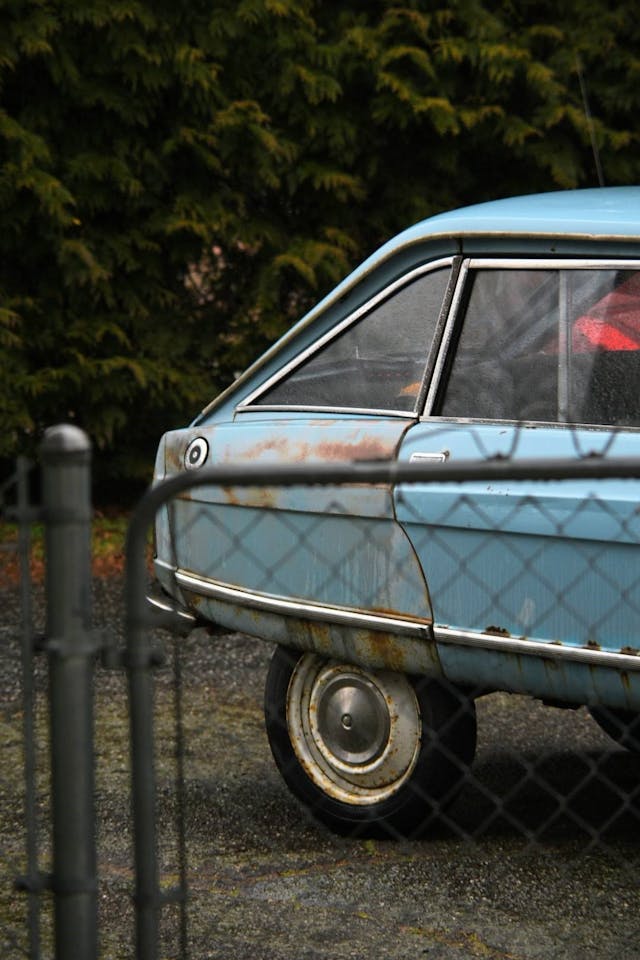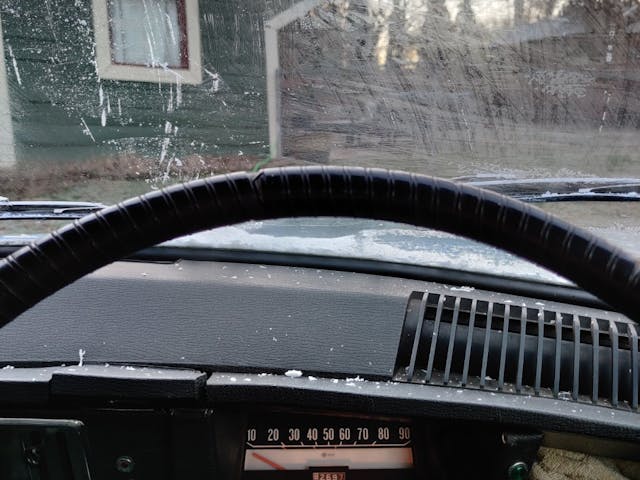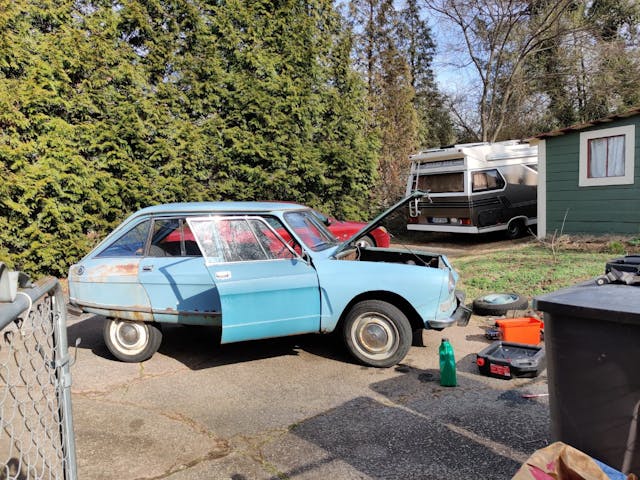Against All Oddities: Mantras for a 33-hp commuter car
Matthew Anderson is an American engineer who relocated to Germany a few years ago for work. He’s back now, but his baffling pursuit of unexceptional and oddball cars continues. We don’t ask him too many follow-up questions.
My daily driver at the moment has less output than a top-of-the-line zero turn lawnmower. Let me tell you, 33 horsepower requires a different kind of driving attitude. For one, I find myself praying more often. Not to any deity in particular as much as the universe at large. Certain mantras tame the fear of getting squeezed out of merge lanes, and they seem to help defrost the windshield faster. Or am I just imagining things?
I never intended to use my 1972 Citroën Ami 8 this way. The newest and most comfortable car in my stable is a 2003 Ford Taurus SES. Plans to get my wife’s Studebaker road-ready went awry, so she’s commandeered the Ford for the foreseeable future. After determining that neither my Moskvich nor my Wohnmobil were, uh, optimal commuter vehicles, my options dwindled.
Slow but therapeutic, the Ami ekes 33-cheveaux out of 602 cubic centimeters. Over the years it’s carried me 15,000 miles at a pace that demands zen-like patience. Here’s what I’ve learned driving it to and from work this spring:

Go placidly amid the mayhem
Each morning and evening, I commute either 25 or 38 miles each way, depending on which office I need to visit. This amounts to roughly 45 minutes or so of underpowered Citroën boxer thrumming. Its rhythmic resonances are loud but oddly calming. The motor is ambivalent to your inputs, it just presses on like an ocean current, doing what it can.

Driving this particular Ami feels like piloting a motorcycle from inside an enclosed sidecar. With no real heat or defrost functionality, there are considerable smells, tingling extremities, and a keen awareness of weather conditions. Despite that, the interior is comfortable even when wind gusts threaten to send me across lanes and subtract from my top speed. The interior is open and airy, the seats well worn. Imagine dozing off in a recliner while looking out a single-pane glass window at the tornado going on outside. The cockpit of an Ami is something like that.

Mind the gap
On my commute, I’ve noticed that the Broad Street ramp in my town of Statesville, North Carolina has a particularly tight radius. So much so that the Ami cannot safely slingshot me into the traffic stream of angry Chargers and zig-zagging straight-piped Silverados. The laid merge lane is over one full quarter mile long, but it’s all uphill, and thus too risky.
I usually head one exit down to a short-yet-level area that lets me build velocity to an acceptable level before attempting a merge onto the main road. Even that feels like a 50/50 dance with death, most of the time. How fast do I want to take this corner? How aggressively do I want to cut off this Chevy Equinox? How alive do I want to arrive at work? When I’m lucky, I do my best to cut off the lightest possible vehicle with the friendliest-looking occupants. Then I wave apologetically. Désolé pour mon Ami, mes amis!
Comparison is the thief of joy
Standstill takeoffs are not among the Ami’s strengths. I am but a speck at spotlights, and a speck I remain when the light turns green. Now awash in ever-growing crossovers, modern American motorists have purged from memory the existence of small, underpowered vehicles. The notion of one with an unsynchronized, manually crunched first gear is basically incomprehensible to them.
It’s like standing in front of the sliding doors at a midnight Black Friday sale for a hotly anticipated gaming console. Then, precisely at the moment when the doors slide open, you drop your phone. There’s no chance of making it to the register first, so you pretty much just let the crowd pass and try not to get trampled.
Fuel economy, on the other hand, I will gladly brag about. I get FIFTY—as in five-zero—miles per precious gallon. Come at me, ye Raptors, and humble thyself before such efficiency!
Celebrate the wins
Maintenance is a good opportunity for a pat on one’s own back and good prep for the next outing. Basking in the success of a roadside repair is just as therapeutic as the journey itself, but, I generally advise preempting such disasters by partaking in regular preventative maintenance. This being a trusty 2CV-based vehicle, one doesn’t really need to worry about extensive wrenching hours. Take brake pads for example: What might be an hour or so in an American car is only about 9 minutes per side, even if you’re new to inboard Citroën brake service. All it takes is a long, dirty slotted screwdriver and decent vision (so wear eye protection!). Pro tip: An Ami oil change requires a special filter that’s actually easier to find if you tell the auto parts store that it’s for a Simca 1204. With regards to oil spend, 2 quarts just about does it.

Let’s not forget that good deals are worth cheering for, too. Parts are readily available online for downright cheap prices; for about $400 I was able to get replacement door cards, an emergency brake handle, a fuel pump, brake pads, and a few other bits-n-bobs. And … there is no cooling system to explode in traffic! Air-cooled for the win!

All is as it should be
My cat sits next to the Ami when it’s stashed in the barn, so I can only assume he approves of it. Still, I think the Citroën is better suited as a weekend classic than a commuter classic. My first commute in my newly imported Carina GT reminded me what a joy 20 valves, four throttle bodies, and functional heat can bring. The Citroën possesses more of that special je-ne-sais-quoi, but I think I’ll savor it more if I don’t have to hastily aim the car at a morning meeting in a 36-degree rainstorm.
Merci, mon Ami.




I’m just wondering if my ’98 Chev S10 with a really bad-running pushrod 4 putting out maybe 60 of its claimed 110 horses in a heavy chassis qualifies for this category? 🙂
We wouldn’t kick you out!